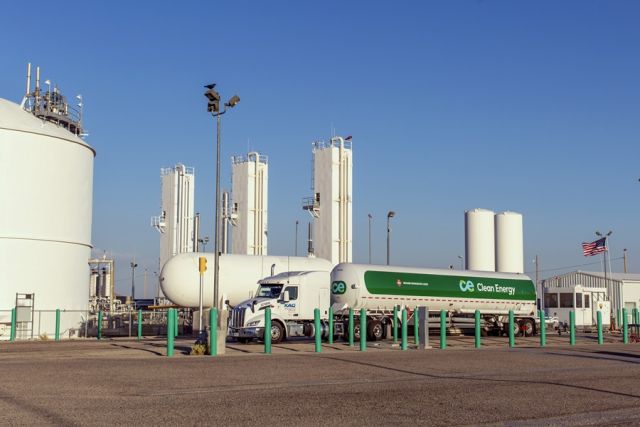
Clean Energy Boron LNG Plant's three Production Trains (Photo: Business Wire)
Clean Energy Fuels Corp. has completed construction of a third production train at its LNG plant in Boron, California, to increase its volume capacity by 50%, the company said on June 11.
TPH analyst Matthew Blair said the new capacity could increase Clean Energy’s EBITDA by $2 million and eliminate its reliance on third-party LNG suppliers.
“The release didn’t provide an estimate for an EBITDA uplift from the project, but management has previously noted that downtime at its smaller 28mmgal [million gallons] Pickens LNG plant in Texas cost the company about $0.3mm per quarter,” Blair said in a June 11 commentary.
At a similar unit profitability, the Boron expansion could up profitability by $2 million per year.
“The expansion also is likely to eliminate CLNE’s reliance on 3rd party suppliers for LNG, which accounted for 17% of CLNE’s LNG volumes in 2023, up from 8% in ‘22 due to downtime at the Pickens plant last year. Maintain Buy on CLNE,” Blair said.
Clean Energy’s current LNG capacity can produce up to 270,000 gal/d, or about 367,000 metric tons per year, according to the company. A third production train would allow supply to meet the growing demand for bulk LNG for customers that want to decarbonize “everything from city buses to large container ships,” according to a press release.
Clean Energy customer Pasha Hawaii operates three LNG-powered container ships out of the Ports of Long Beach, Oakland and Honolulu. Fuel volumes for the MV George II, MV George III and MV Janet Marie grew in April to 2.11 million gallons in April 2024 from 526,486 gallons in August 2022.
Pasha Hawaii’s ships LNG fueled ships surpass the International Maritime Organizations 2030 standards for ocean vessels with zero sulfur emissions, Clean Energy said.
“Pasha Hawaii’s leadership in sustainable shipping has grown with the commissioning of their third LNG-powered ship. By growing their LNG-fleet, they are reducing pollution and carbon emissions around the ports and showing that LNG can work as effectively as their fuel oil counterpart. The addition of more LNG production at our Boron facility will give us the capacity to allow other customers the ability to decarbonize their operations,” said Greg Roche, vice president at Clean Energy.
Recommended Reading
E&P Highlights: Feb. 10, 2025
2025-02-10 - Here’s a roundup of the latest E&P headlines, from a Beetaloo well stimulated in Australia to new oil production in China.
E&P Highlights: Feb. 24, 2025
2025-02-24 - Here’s a roundup of the latest E&P headlines, from a sale of assets in the Gulf of Mexico to new production in the Bohai Sea.
Murphy’s Vietnam Find May Change Investor Views, KeyBanc Analysts Say
2025-01-09 - The discovery by a subsidiary of Murphy Oil Corp. is a reminder of the company’s exploration prowess, KeyBanc Capital Markets analysts said.
Hibernia IV Joins Dawson Dean Wildcatting Alongside EOG, SM, Birch
2025-01-30 - Hibernia IV is among a handful of wildcatters—including EOG Resources, SM Energy and Birch Resources—exploring the Dean sandstone near the Dawson-Martin county line, state records show.
E&P Highlights: March 10, 2025
2025-03-10 - Here’s a roundup of the latest E&P headlines, from a new discovery by Equinor to several new technology announcements.
Comments
Add new comment
This conversation is moderated according to Hart Energy community rules. Please read the rules before joining the discussion. If you’re experiencing any technical problems, please contact our customer care team.




